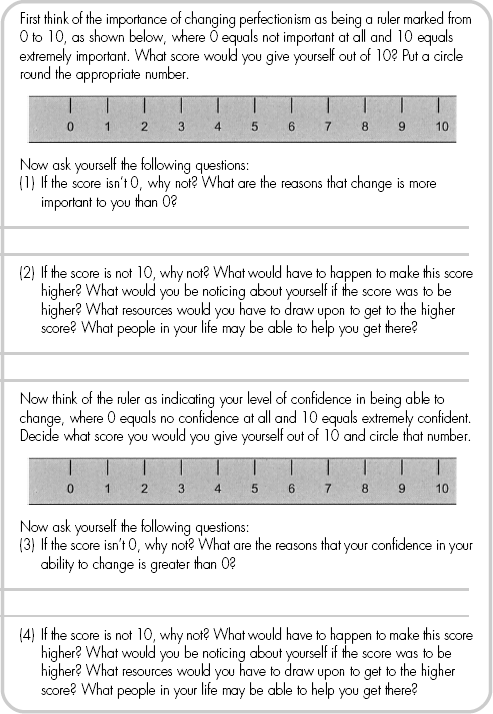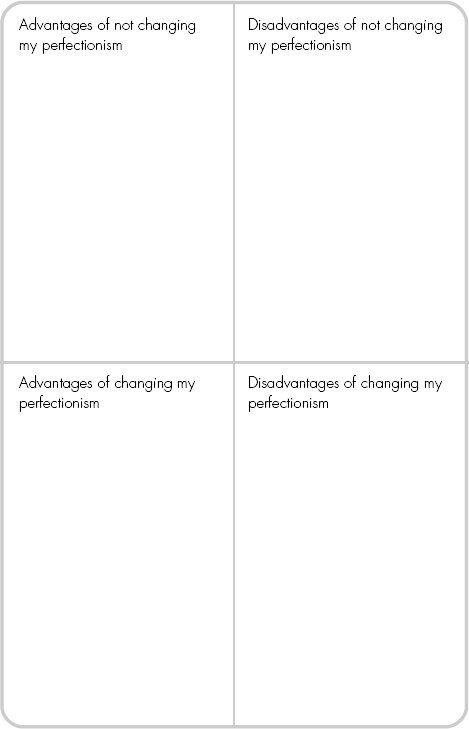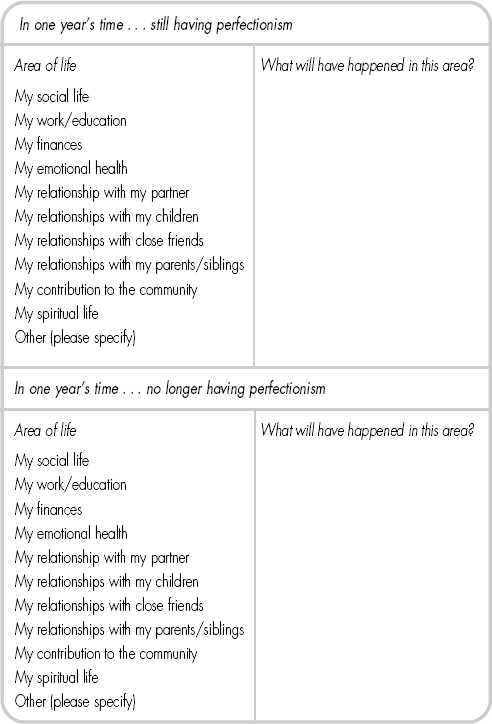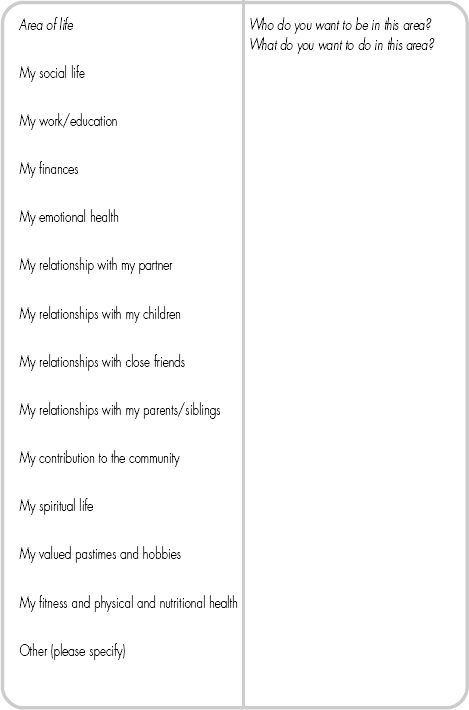
The fact that you are reading this book means that part of you is considering changing your perfectionism, presumably with the goal of keeping the good aspects but reducing the damaging impact it currently has on your life. Even though change can mean improving your life, it’s not easy to decide to change long-held habits and patterns of behavior. These habits and patterns emerged for a reason and may still perform some useful functions, or achieve certain goals in your life. However, these habits and patterns are also having damaging consequences in your life, some of which were outlined in Chapter 2. Thus people approach the idea of change with mixed feelings – being caught between fearing the consequences of change and wanting the benefits of change. The purpose of this chapter is to help you explore these mixed emotions and count the cost of change before you embark on this process.
The first thing to ask yourself is: how important is it to you to change the way perfectionism impacts on your life? You can find this out by completing the first part of Worksheet 6.1. If it turns out that it is not very important for you to make changes, you may need to ask yourself if this is the right time to start working on your perfectionism.
Take some more time to think through why it is important for you to change. Think about the pros and cons of keeping things as they are and allowing the current impact of perfectionism on your life to continue by completing Worksheet 6.2.
First, list the advantages of keeping things the same in the box headed ‘Advantages of not changing my perfectionism’. Second, think of the advantages of changing your perfectionism and write these down under the heading in the lower left-hand box. Now, think of the question the other way around. What would be the disadvantages of not changing your perfectionism and what would be the disadvantages of your perfectionism continuing as it is now? Write these down under the appropriate headings in the right-hand pair of boxes.
It may help to reread Chapter 2 of this book as you do this exercise, in order to make sure you have captured all the disadvantages in your life.
Don’t worry if you found it difficult to complete Worksheet 6.2. Sometimes people find it hard to think of the advantages and disadvantages of change when they have been living with an unhelpful behavior for so long. It can help to think of the questions from other perspectives – for example, by looking at the situation through someone else’s eyes. Choose a person who is close to you and cares for you – now go back to the boxes, and consider each of the headings again from this person’s eyes. What advantages and disadvantages would they see for you in staying the same or making changes? Add these thoughts to the boxes. If it helps, it may be useful actually to ask the person these questions. Sometimes you will be surprised at what others notice about the destructive influences of perfectionism on your life.


Another perspective that can help when thinking about the pros and cons is considering what your life might be like in the future without change, and with change. It can feel difficult to make changes in the present; perhaps you feel it would be better to wait for ‘a better time’. However, if you consider what the future will look like if you don’t change, this can sometimes make beginning to change look more urgent. Look at the first box in Worksheet 6.3 and consider what will be happening in the various areas of your life one year from now if there is not a change in the perfectionism in your life. Write down the ideas as they come to you. Now do the same for the next box, thinking about how these areas in your life will look if the impact of perfectionism in your life is reduced.
Now, when considering everything you have written in the three worksheets so far, answer the following questions:

The major fear that may hold some people back from working to change their perfectionism is that they fear their lives will not function as well without it. If you have been judging your worth according to your ability to meet high standards, then you may feel that the process of change will leave you feeling utterly lost, like trying to navigate through the Amazon jungle without a guide or a compass. Impossible. How will you know if you are worthwhile? How will you judge yourself as a person? Your confidence in being able to run your life without perfectionism may be low. Consider the example of Gloria below and see if any of these issues apply to you.
Gloria: What perfectionism was achieving in her life
Gloria is a second-year university student and has always had high standards for her academic achievement. This caused her problems in her final year at school, as she was reluctant to hand in anything that she did not consider ‘perfect’. This reluctance stemmed from worrying about what her teacher would think about her if the work was not excellent. She feared that the teacher might respect her less and consider her to be a student who was not worthwhile spending time on. Gloria also felt that she was letting herself down if she produced less than excellent work, and that she would become a second-rate person if she started handing in only ‘good enough’ pieces of work. Fortunately at this time she was able to discuss these fears with the teacher, and the teacher was able to help her hand in work that Gloria considered was not yet excellent enough for marking. Gloria always achieved high marks for these pieces of work, even though she considered them to be unpolished and unfinished products. However, when Gloria started attending university, she encountered these same problems but felt unable to talk to others about them. She stopped participating in tutorials or attending workshops, as she worried that other people would consider her input unsatisfactory and think she was a failure as a person. The same issues started to cause problems for Gloria in her part-time work as an administrative assistant. She feared that less than perfect work would show people how hopeless she was as a person and so she avoided completing certain tasks. Even though the costs of perfectionism mean that Gloria is failing at university and also in danger of losing her part-time job, Gloria herself still fears that she might become a second-rate person if she changes her perfectionism in the areas of study and work.
One way of increasing your confidence about changing and not relying on always attaining high standards in order to feel good about yourself is to think about identifying yourself as a person who has something to offer across many life areas rather than just one or two. You may also like to consider who it is you want to be in these areas, as opposed to what you want to achieve. In Worksheet 6.4 you can see the same areas of life you considered earlier. Consider who it is you want to be and what you want to do in each of these areas. In what ways will your life look different if you start to enrich all these areas rather than spending so much of your time pursuing excellence in just one or two?
One great advantage of spreading how you judge yourself as a person across many areas of your life is that you are no longer ‘putting all your eggs into one basket’. If you are judging yourself on just a few areas of your life, then if things are not going well in these areas you will be judging yourself harshly as a person. If you are putting your eggs in a few different baskets, then when things do not go right in one area, the chances are that something will be going fine in another area, or that you are satisfied with your life in another area.

You can use the information you have set down in Worksheet 6.4 to step back and see the whole picture of who you are as a person, rather than judging yourself on that one bit of work or that one performance that you considered was not up to scratch.
You have done a lot of thinking as part of working through this chapter. Now for one last thing! Go back to the ‘importance’ and ‘confidence’ rulers at the start of the chapter (Worksheet 6.1). Think about where you would put yourself now. Have your ratings changed at all? If so, reflect on what has happened to make you change these ratings. It may be useful to discuss this with another person who you feel is an important support in your life.
Even if you still have some doubts, we encourage you to give the ideas in this book a wholehearted try. You will soon be aware of change, and will see the freedom and flexibility you will gain without a big decrease in performance. Once you see that these changes are helpful and improve your quality of life, you are in a position to decide if you want to continue with further change.
TAKE-HOME MESSAGE